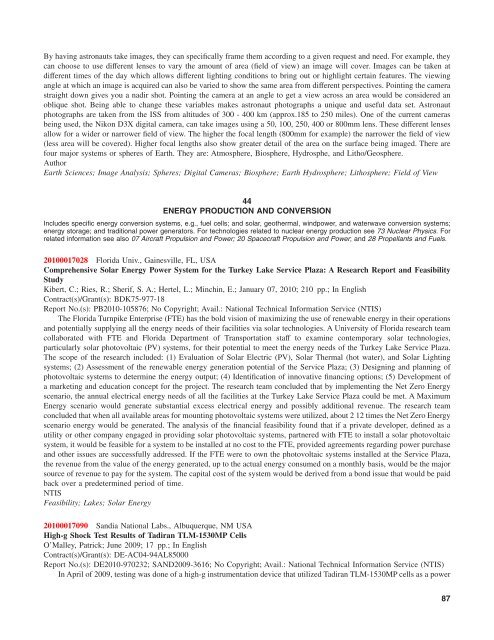NASA Scientific and Technical Aerospace Reports - The University ...
NASA Scientific and Technical Aerospace Reports - The University ...
NASA Scientific and Technical Aerospace Reports - The University ...
Create successful ePaper yourself
Turn your PDF publications into a flip-book with our unique Google optimized e-Paper software.
By having astronauts take images, they can specifically frame them according to a given request <strong>and</strong> need. For example, they<br />
can choose to use different lenses to vary the amount of area (field of view) an image will cover. Images can be taken at<br />
different times of the day which allows different lighting conditions to bring out or highlight certain features. <strong>The</strong> viewing<br />
angle at which an image is acquired can also be varied to show the same area from different perspectives. Pointing the camera<br />
straight down gives you a nadir shot. Pointing the camera at an angle to get a view across an area would be considered an<br />
oblique shot. Being able to change these variables makes astronaut photographs a unique <strong>and</strong> useful data set. Astronaut<br />
photographs are taken from the ISS from altitudes of 300 - 400 km (approx.185 to 250 miles). One of the current cameras<br />
being used, the Nikon D3X digital camera, can take images using a 50, 100, 250, 400 or 800mm lens. <strong>The</strong>se different lenses<br />
allow for a wider or narrower field of view. <strong>The</strong> higher the focal length (800mm for example) the narrower the field of view<br />
(less area will be covered). Higher focal lengths also show greater detail of the area on the surface being imaged. <strong>The</strong>re are<br />
four major systems or spheres of Earth. <strong>The</strong>y are: Atmosphere, Biosphere, Hydrosphe, <strong>and</strong> Litho/Geosphere.<br />
Author<br />
Earth Sciences; Image Analysis; Spheres; Digital Cameras; Biosphere; Earth Hydrosphere; Lithosphere; Field of View<br />
44<br />
ENERGY PRODUCTION AND CONVERSION<br />
Includes specific energy conversion systems, e.g., fuel cells; <strong>and</strong> solar, geothermal, windpower, <strong>and</strong> waterwave conversion systems;<br />
energy storage; <strong>and</strong> traditional power generators. For technologies related to nuclear energy production see 73 Nuclear Physics. For<br />
related information see also 07 Aircraft Propulsion <strong>and</strong> Power; 20 Spacecraft Propulsion <strong>and</strong> Power; <strong>and</strong> 28 Propellants <strong>and</strong> Fuels.<br />
20100017028 Florida Univ., Gainesville, FL, USA<br />
Comprehensive Solar Energy Power System for the Turkey Lake Service Plaza: A Research Report <strong>and</strong> Feasibility<br />
Study<br />
Kibert, C.; Ries, R.; Sherif, S. A.; Hertel, L.; Minchin, E.; January 07, 2010; 210 pp.; In English<br />
Contract(s)/Grant(s): BDK75-977-18<br />
Report No.(s): PB2010-105876; No Copyright; Avail.: National <strong>Technical</strong> Information Service (NTIS)<br />
<strong>The</strong> Florida Turnpike Enterprise (FTE) has the bold vision of maximizing the use of renewable energy in their operations<br />
<strong>and</strong> potentially supplying all the energy needs of their facilities via solar technologies. A <strong>University</strong> of Florida research team<br />
collaborated with FTE <strong>and</strong> Florida Department of Transportation staff to examine contemporary solar technologies,<br />
particularly solar photovoltaic (PV) systems, for their potential to meet the energy needs of the Turkey Lake Service Plaza.<br />
<strong>The</strong> scope of the research included: (1) Evaluation of Solar Electric (PV), Solar <strong>The</strong>rmal (hot water), <strong>and</strong> Solar Lighting<br />
systems; (2) Assessment of the renewable energy generation potential of the Service Plaza; (3) Designing <strong>and</strong> planning of<br />
photovoltaic systems to determine the energy output; (4) Identification of innovative financing options; (5) Development of<br />
a marketing <strong>and</strong> education concept for the project. <strong>The</strong> research team concluded that by implementing the Net Zero Energy<br />
scenario, the annual electrical energy needs of all the facilities at the Turkey Lake Service Plaza could be met. A Maximum<br />
Energy scenario would generate substantial excess electrical energy <strong>and</strong> possibly additional revenue. <strong>The</strong> research team<br />
concluded that when all available areas for mounting photovoltaic systems were utilized, about 2 12 times the Net Zero Energy<br />
scenario energy would be generated. <strong>The</strong> analysis of the financial feasibility found that if a private developer, defined as a<br />
utility or other company engaged in providing solar photovoltaic systems, partnered with FTE to install a solar photovoltaic<br />
system, it would be feasible for a system to be installed at no cost to the FTE, provided agreements regarding power purchase<br />
<strong>and</strong> other issues are successfully addressed. If the FTE were to own the photovoltaic systems installed at the Service Plaza,<br />
the revenue from the value of the energy generated, up to the actual energy consumed on a monthly basis, would be the major<br />
source of revenue to pay for the system. <strong>The</strong> capital cost of the system would be derived from a bond issue that would be paid<br />
back over a predetermined period of time.<br />
NTIS<br />
Feasibility; Lakes; Solar Energy<br />
20100017090 S<strong>and</strong>ia National Labs., Albuquerque, NM USA<br />
High-g Shock Test Results of Tadiran TLM-1530MP Cells<br />
O’Malley, Patrick; June 2009; 17 pp.; In English<br />
Contract(s)/Grant(s): DE-AC04-94AL85000<br />
Report No.(s): DE2010-970232; SAND2009-3616; No Copyright; Avail.: National <strong>Technical</strong> Information Service (NTIS)<br />
In April of 2009, testing was done of a high-g instrumentation device that utilized Tadiran TLM-1530MP cells as a power<br />
87

















